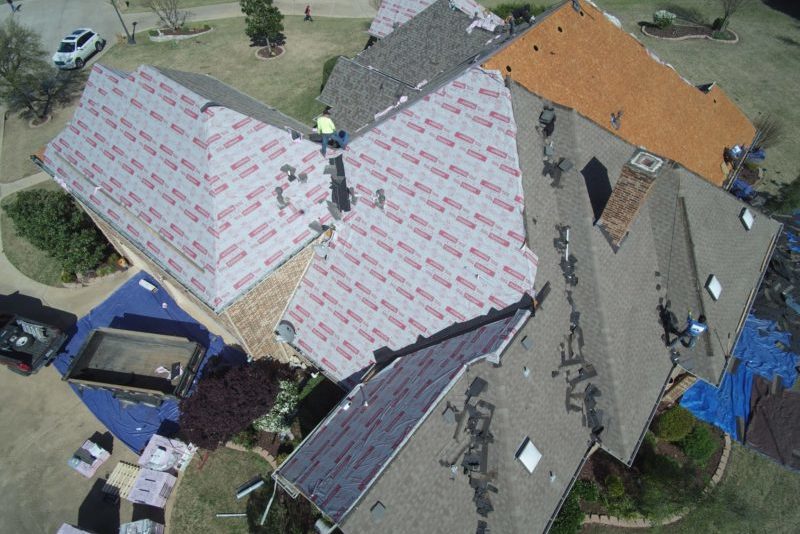
When you consider your options for a new roof, you likely think about asphalt shingles, architectural tiles, metal or clay tiles. Those materials have functional as well as aesthetic qualities. But there’s also a functional part of the roof that you don’t see.
What is Roof Underlayment?
Rafters or trusses make up the skeleton of your roof. Those are covered by the roof deck, which is typically constructed of plywood or a type of plywood composite called OSB. The roof deck is covered by a barrier that lies on top of the roof deck and under the outer layer or roofing. Experts refer to this membrane as the underlayment.
What is Roof Underlayment Used For?
Each layer of roofing material has an important job. The outermost shingles reflect the sun’s rays while protecting your home from the elements. They also help with debris resistance and temperature control. But if you relied on that layer alone to safeguard a structure, you would run into problems quickly if it became damaged.
The roofing underlayment creates a secondary barrier against rain, wind and sun. It keeps the roof deck and the area below it safe if your shingles become chipped or damaged. You’ll have to make repairs soon enough, but a minor roof problem isn’t an emergency if you have the right kind of underlayment.
The underlayment is also the primary barrier while the house is being built. It keeps the wood underneath it dry until the outer roofing surface is installed.
Without underlayment, your roof decking would be exposed to moisture. It could develop rot, mold and mildew problems and weaken the structure of the building. Unsuitable underlayment also contributes to condensation on your attic ceiling.
Acceptable Roof Underlayment Types
Local building codes require your structure to have an appropriate roof covering, which includes an underlayment. The manufacturer’s warranty that comes with the shingles is only valid if your roof is installed correctly. Failing to use underlayment or installing it incorrectly voids the warranty.
There are different types of roof underlayment available, however. The right one to use depends on building codes, the style of roof that you have and the region of the country in which you live.
Felt Underlayment
Felt underlayment has been used for about a century. Sometimes called tar paper, it is still one of the common roof underlayment types.
Made of dense paper or fiberglass mat that has been saturated with asphalt, felt underlayment resists water. It’s attached to the roof deck using staples or roofing nails. No. 15 felt is the lighter version. It can be used for small projects, but this type tears easily if it’s handled roughly or blown off in a storm. No. 30 felt is thicker and more durable.
The benefits of felt underlayment include:
- Low cost
- Readily available
- Can add layers for extra protection
- Works well with slate roofing
The downsides of felt underlayment are as follows:
- Not completely waterproof
- Can’t be exposed to the elements for too long
- Not ideal for high-heat environments
- Wrinkles when exposed to excessive moisture
- More difficult than other types to install
Synthetic Underlayment
Synthetic underlayment is made of plastic, which is more water resistant and durable than felt. There is no standard synthetic underlayment. Therefore, you have plenty of options when using this material.
Many synthetic underlayment products have multiple layers that are designed for specific purposes. For example, the top layer might stay cool in the sun and provide an anti-slip surface, which is makes installation safer and easier. Roofers attach synthetic underlayment to the decking using plastic-capped nails.
The benefits of synthetic underlayment include:
- Faster, safer installation
- Lighter in weight than felt
- Not likely to wrinkle or tear
- Stays flexible in cold or warm weather
- Protects better than felt
There aren’t many downsides of synthetic underlayment beyond its higher initial investment.
Self-Adhered Underlayment
This type of underlayment is made of rubber and asphalt polymers. It’s extremely water-resistant and has a sticky feel. Its texture allows it to adhere to the roof deck, which protects it better than the other types of underlayment.
The product self-seals around uneven areas and fasteners, leaving little room to trap moisture. This feature is especially effective for leak-prone areas, such as the flashing around chimneys, skylights and vents.
The benefits of self-adhered underlayment include:
- Performs well in cold weather
- Provide a secure seal against water
- Extremely long-lasting and durable
- Resistant to tearing and wrinkling
- Stands up to extreme temperatures
The main disadvantage of self-adhered roofing underlayment is the complex installation process.
Choosing the Best Type of Roof Underlayment
Your roof will last a long time if it’s installed properly. But if you don’t have adequate underlayment, you’ll develop moisture problems that speed up the deterioration of the entire structure. Leaks and roof damage can also ruin your walls, flooring, furniture and valuables inside the house.
Whether you’re getting a metal, tile, Decra or asphalt roof, protect your investment with the right underlayment. The team of experts at Presidio Roofing will help you choose the best option so that you can trust in the security of your roof.





